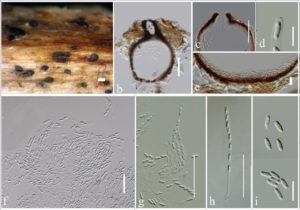Tenuimurus clematidis Senan., Camporesi & K.D. Hyde, sp. nov.; Index Fungorum number: IF552316
Etymology: In reference to the host genus Clematis.
Saprobic on Clematis vitalba L. Sexual morph: Ascomata 125–180 μm high × 130–170 μm diam., (x = 150 × 156 μm, n = 10), solitary to aggregated, immersed, globose to subglobose, membranous, coriaceous, brown, developing under a small blackened clypeus, ostiolate, papillate. Papilla 58–65 μm high, 35–45 μm wide (x = 60 × 40 μm, n = 10), short, central, periphysate. Peridium 10–15 μm wide (x = 13 μm, n =10), comprising inner, hyaline, thick-walled elongated cells and outer, brown, thick-walled elongate cells. Hamathecium comprising hypha-like, filamentous, septate, distally tapering, hyaline, paraphyses. Asci 55–80 × 7–7.5 μm (x = 68 ×7 μm, n=20), 8-spored, unitunicate, cylindrical, thin-walled, pedicellate, with a refractive, J-, apical ring. Ascospores 9–10 × 3–3.5 μm (x = 9.5 ×3.2 μm, n =20), uniseriate, ellipsoidal, hyaline, unicellular, bi-guttulate, guttules located at ends of the cell. Asexual morph: Undetermined.
Culture characteristics: Colonies on MEA, slow growing, reaching 2 cm after 14 days at 18°C, circular, flat, filiform, white, dense colonies, somewhat tightly attached to the media.
Material examined: ITALY, Province of Forlì-Cesena
Notes: Tenuimurus is a monotypic genus, introduced based on T. clematidis. This genus morphologically differs from other genera in Phomatosporaceae as Tenuimurus has a dark, thin, delicate, peridium with small asci (< 80 μm in high) and smaller ascospores (< 10 μm in length). The phylogenetic analysis in this study provides high support (MLB/PP=94/0.9) for Tenuimurus as a distinct genus. No species of Phomatospora are known from Clematis (Farr & Rossman 2016).
Fig. Tenuimurus clematidis (holotype). a. Appearance of ascomata on substrate. b. Cross section of ascoma. c. Papilla. d. Apical ring. e. Peridium. f–h. Asci. i. Ascospores. Bars: a = 100 μm, b, c, e = 50 μm, f = 20 μm, g, h = 50 μm, i, d = 10 μm.

